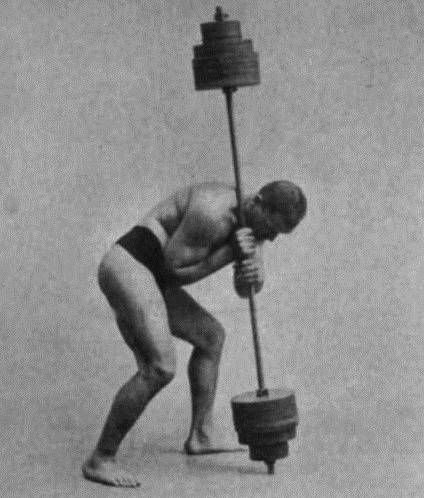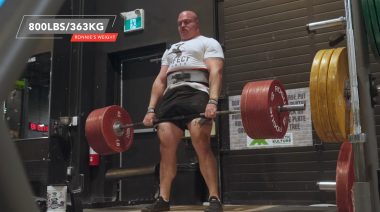Lately, there’s a lot of talk about the bent press. You may have noticed in my article on that classic lift that you begin the movement with the barbell basically in a clean position, except with just one hand. Furthermore, one side of the barbell needs to be behind your head. Thus performing a one-hand clean is not the best option to get into this starting position.
So how do you get the barbell into place to perform the bent press? By an old-time lift known as shouldering a barbell. This exercise is something you just don’t see anymore. Since the bent press became less popular, this movement did as well.
Learning how to properly shoulder a barbell is essential to learning the bent press.
Why Try Shouldering?
Before you write this exercise off, know that shouldering is not just for the bent press. This exercise can also be used as a setup for a one arm jerk or push press with a barbell.
Not to mention, shouldering is a great exercise by itself. It may appear at first glance that it will not be hard, but the first time you try a heavy weight, you’ll realize you are mistaken. Your legs, back, abs, obliques, and arms are all put to the test during this movement.
And as there is lop-sided loading on your body, this is certainly one of those exercises that challenges you much more in an odd way than most conventional exercises.
Get Ready for a New Challenge
This video showcases me shouldering 185lbs. I challenge you to do the same.
Here are the basic steps:
- Stand up the barbell vertically on one end. Make sure the collars you use are tight and will not slide off during the movement.
- Place your main hand that will be lifting in the center of the barbell.
- Place the other hand immediately below the first hand.
- Lean back and heave the barbell to your shoulder as you partially squat and partially hinge at the hips.
- Come to a standing position and get ready for the “actual” exercise. If you are only shouldering the barbell you can lower it to the ground in the same manner.
You can easily manhandle light weights into place, but this technique must be practiced for the heavy weights. By itself, it’s quite a leverage lift.
The Shouldering Master
Arthur Saxon, an old-time strongman known for bent pressing 370lbs, was obviously a master at this lift because it was how he got the weight into place for the press. In The Text Book of Weightlifting, he describes the exercise in more detail:
To do this properly, the upright bell should be grasped with the right hand in the exact center, the feet being well apart (if possible, exactly in the positions they will occupy throughout the lift).
Fix the right elbow, resting firmly on the hip bone in front, and grasp the bell with the left hand, immediately below the right.
Bend well forward, leaning your head right over; bend the legs well at the knees, and pull the weight over on to your shoulder.
In order to do this properly, you must lift strenuously with both hands, leaning well back and levering the bar over by the help of both your hip bones to secure and maintain your purchase, and of your shoulder, which you naturally slide as far as you can under the bar.
The hoist to the shoulder is rendered easier by the weight of the bell itself, the top sphere or discs being unsupported in any way, helping to pull the front spheres or discs upwards. A greater weight can be lifted by the bent press, if the bell be shouldered in one movement, since less energy is expended thereby; but if it will not come over at once, an additional heave becomes necessary. In order to avoid any necessity for two or three hoists (always exhausting) use as long a bar as is obtainable.
Once, however, it is fairly shouldered, the left hand can release its hold and be thrown out to adjust the balance, while the right, after steadying the bell, shifts round gradually, following the elbow as it slides round the hip bone to the back, into the proper position for the body press.
The method described above necessitates a fairly long bar for its perfectly correct performance, and other methods must be adopted with shorter ones.

Arthur Saxon was a master at shouldering barbells.
You’ll likely have to read through these instructions several times while practicing in order to really get a feel for what Saxon is saying. Also, note that back in Saxon’s day, barbells weren’t as standardized as they are now. I would imagine that our standard Olympic bars coming in at seven feet would classify as a long bar.
In another of Saxon’s books, The Development of Physical Power, he describes a second, slightly different method:
Another method is to place the left hand at the bottom of the bar above the discs, your left arm to be straight and your right to be bent and resting across the body. Stand as close to the bar as possible, instead of away from, as in the preceding position, and bend the legs to a greater extent, then raise the bar to your chest and lift with both the left arm and the right arm together, suddenly tossing the bottom set of discs away from you and to the left, at the same time quickly bringing the right elbow on to the body. The first method is more suitable for long bars, and the second method for short bars.
As always, I recommend experimentation. Try both methods and see if one may be more suitable to you than the others.
Always Aim for Balance
When it comes to training shouldering, I highly encourage you to attempt it on both sides of your body, for the sake of symmetry, though you may find one side to be much stronger than the other.
Also, this isn’t an exercise to rep out with. I encourage the use of singles, working your way up to a max. As I mentioned before, this may challenge your body in ways you’ve never experienced before. Give it a shot and see for yourself.
If you have questions or if you’ve tried this movement and want to share how it went for you, please post to the comments below.
References:
1. Arthur Saxon, The Development of Physical Power (South Carolina: Strongman Books, 2010), 32–33.
2. Arthur Saxon, The Text Book of Weightlifting (South Carolina: Strongman Books, 2010), 25-26.
Check Out These Related Articles:
- How to Get Strongman Strong With the Bent Press
- Strongman Profile: Arthur Saxon
- Get Stronger Today With Lessons From Old-Time Strongmen
- What’s New On Pulse Beat Fit Today






